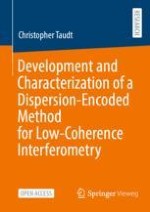Open Access 2022 | Open Access | Book

Development and Characterization of a Dispersion-Encoded Method for Low-Coherence Interferometry
Author: Christopher Taudt
Publisher: Springer Fachmedien Wiesbaden
Open Access 2022 | Open Access | Book

Author: Christopher Taudt
Publisher: Springer Fachmedien Wiesbaden
This Open Access book discusses an extension to low-coherence interferometry by dispersion-encoding. The approach is theoretically designed and implemented for applications such as surface profilometry, polymeric cross-linking estimation and the determination of thin-film layer thicknesses. During a characterization, it was shown that an axial measurement range of 79.91 µm with an axial resolution of 0.1 nm is achievable. Simultaneously, profiles of up to 1.5 mm in length were obtained in a scan-free manner. This marked a significant improvement in relation to the state-of-the-art in terms of dynamic range. Also, the axial and lateral measurement range were decoupled partially while functional parameters such as surface roughness were estimated. The characterization of the degree of polymeric cross-linking was performed as a function of the refractive index. It was acquired in a spatially-resolved manner with a resolution of 3.36 x 10-5. This was achieved by the development of a novel mathematical analysis approach.